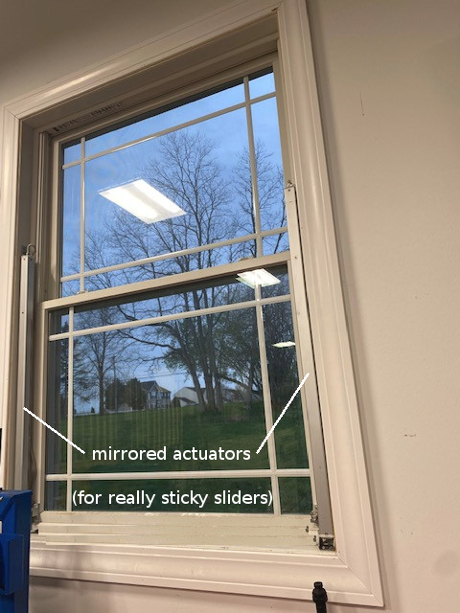Adrian Biffen, Senior Partner
10 popular questions about this type of automatic window opener (vertical sliders):
Q: What are single-hung and double-hung window motors?
A: Single/double hung motors are devices that automatically raise and lower the window. We refer to them as “sliders”.
Q: How do “sliders” work?
A: It contains a moveable part that functions as a vertical “slider” to lift your window to open it. Here is a short video showing how our actuators work to raise and lower the sash (the unit is controlled by a switch or remote control):
Q: What are the benefits of an automatic motorized slider?
A: Benefits include allowing you to open and close windows easily, providing ventilation, security when closed, and convenience.
Q: What size motor do I need for my automatic slider?
A: The size depends on the weight and size of your window opening. Our actuators are capable of a 40 lb lift,and can be “mirrored” to go on either side of the slider for very sticky (or stuck) windows. This is generally more power than is needed, but you can test the required lift by using a luggage weight scale.
Q: Do these sliders require special considerations?

A: No, you just mount them with screws on either side of the slider (if mirrored), or on just one side (if your unit slides freely). Note that our low voltage motors have no shock hazard.
Q: Can I install a slider myself?
A: Yes, you can! These units are designed for the DIY (Do It Yourself) homeowner, but you may want to hire someone to do it (no special skills required).
Q: How much does a slider cost?
A: Costs run around $400 for a 40 lb lift device, but keep in mind that you may need 2 of them on either side for very sticky sliders.
Q: Where can I buy a window motor?
A: Our Direct Link in Shopping Cart (note that these are always custom orders, depending on how far you want the actuator to open). Please note that we also have chain openers for skylights and awning windows.
Q: Do you test each motor?
A: Yes, we test every single motor that comes into our warehouse, guanteeing that they work! If a defective motor gets past our inspection, we offer a direct replacement shipped to you for a year.
Q: How can I troubleshoot problems with my window motor?
A: Check power connections, inspect sliders for damage, test switches and remote, and check if anything is obstructing the window sash.
Key Takeaways on Remote Control Sliders
- A single-hung window motor automates the raising and lowering the bottom sash.
- A double-hung window motor essentially does the same thing, but there are 2 moveable windows.
- Benefits include convenience, ventilation, accessibility, and security.
- Motor size depends on sash height, width, and weight. Measure the lift required accurately.
- DIY by the homeowner is easy, and there is no shock hazard.
- Budget about $300 per window, but keep in mind you may need actuators on either side for windows that don’t slide easily.
- Troubleshoot issues by checking the power, remotes, obstructions, and limit switch adjustment.
- Maintain motors with lubrication and by following manufacturer guidelines.
Assembly Components of Electric Sliders
The main components that make up the assembly include:
- Automatic electric motor – Provides the lifting force and motion
- Threaded screw – Transfers power from the motor to the slider
- Control switches – Wired switches or remote control signal the motor
- Limit switches – Stop the motor at fully open and fully closed
- Mounting Hardware – Attaches the slider to the window frame
How the Single Hung and Double Hung Motor Operates
When powered on, here is the step-by-step sequence:
- The switch or remote control sends a signal to the motor.
- The motor turns the threaded screw.
- The drive screw rotates accordingly.
- As the drive screw turns, it moves the sash up or down.
- Limit switches stop the motor when the sash reaches its fully open or closed position.
- Note that these are always “custom” stroke, depending on how far you want your window to open.
Motor Direction and Reversing
- To lower the sash, the motor runs in one direction.
- To raise the sash, the motor runs in the opposite direction.
- A switch or remote control changes the direction of the motor.
- Slider will stop if an obstruction is detected.
- Keep in mind that fingers can still be crushed.
Understanding the inner workings of a slider helps ensure proper operation. A functional slider translates into effortless window automation.
Accessibility
- Motorized windows are ideal for those unable to operate manual windows.
- Helpful for those with disabilities or limited mobility.
- Makes windows accessible for elderly users or those unable to reach them.
Other Benefits
- Protects windows from damage caused by forced manual operation.
- Requires no effort to open and close heavy window sashes.
- Allows upper floors/windows to be operated by remote control from the ground level.
| Benefit | Description |
|---|---|
| Convenience | Automated opening and closing |
| Ventilation | Easy to use for air circulation |
| Security | Instantly activate closure from anywhere |
| Accessibility | Helps those unable to operate manually |
Increasing convenience, ventilation, security, accessibility, and ease of use are the main benefits of introducing window motors. Give your manual windows an upgrade with automation!
What Size Motor Do I Need for My Slider?
A motor can make operating your windows effortless, but choosing the right size is important to ensure proper functionality.
The size of the motor needed depends on:
- Height of your window sash – From top to bottom of the movable lower sash.
- Width of your sash – How wide the sash is side to side.
- Weight of the sash – Heavier sashes require more lift capacity.
- Measure the force – With a luggage scale.
- Each slider actuator – Capable of lifting 40 lbs.
Do Sliders Require Special Considerations?
No, introducing a motorized slider is very easy. It requires mounting hardware (provided) that can be fastened to the wall with screws, then you attach the nose piece to the sash.
Electrical Power
- Motors wire directly into a power supply, which plugs into a standard 120 volt outlet.
- if you need to extend your wiring, 16 gauge lamp cord is a good choice because it comes in various colors.
- Electrical work is minimal with our 12 volt units.
- If you live in an area where the grid power fails occasionally, you can use a 12 volt backup battery.
- The battery can also be charged with solar or a small AC float charger.
- Wireless remote controls are internally connected, so you just pair the motor with the remote (we will pre-program kits).
Testing and Adjustments
| Step | Description |
|---|---|
| Mounting rails & brackets | Anchor points for motor to attach to |
| Electrical power | Power supply or battery required |
| Precise measurements | Brackets must align |
| Testing & adjustments | Ensure proper operation |
Can I Provide a Slider Motor Myself?
Yes, providing a DIY slider motor is possible for homeowners. Assessing your skills and preparation is important before tackling this project yourself.
DIY Considerations
- Requires drilling and screwing. If you are capable of this, you are good to go!
- Do you have experience with mechanical equipment and following technical instructions?
- Do you have patience for trial-and-error? Adjustments or corrections are often needed during initial setup.
Benefits of Professional Windows Pro
Hiring a trained window pro has advantages:
- Experts properly size and order the motor based on your window dimensions.
- They have all the necessary tools and materials.
- Professionals can provide a quick service with expertise gained from experience.
- You avoid potential mistakes that lead to problems down the road.
- Window companies provide guarantees.
How Can I Troubleshoot Problems with My Window?
Installing a single-hung window motor brings the convenience of push-button opening and closing, but motorized systems can develop problems. Here are tips for troubleshooting common single hung window motor issues:
Power Connection Issues
First, check that the motor is getting power.
- Verify the outlet or wiring has continuous power flow.
- Check for tripped breakers or blown fuses.
- Ensure cables have solid connections and are not damaged.
Remote Control and Switch Issues
Next, rule out the controls:
- Check remote battery strength. Replace dead batteries.
- Reprogram remotes or control panels if needed.
- Test any wired wall switches for functionality.
Motor Problems
If still not working, the motor itself likely needs attention:
- Listen for motor sounds when pressing the remote. No noise indicates a failed motor.
- Ensure the motor is securely mounted and rails are lubricated.
Obstructions
- Check for objects blocking the sash movement like tree branches or soot buildup.
| Problem | Troubleshooting Tips |
|---|---|
| No power | Check outlets, wiring, fuses |
| Remote issues | Replace batteries, reprogram remotes |
| Motor failure | Listen for noise, inspect gears and mounting |
| Obstructions | Remove branches, debris, buildup |
Regular maintenance and a process of elimination helps diagnose most window problems. Call a professional if issues persist beyond DIY troubleshooting.
Are These Suitable for Doors?
No, they are too slow.
In Summary for Single/Double Hung Windows:
- Single hung window motors conveniently automate opening and closing with the push of a button.
- Choosing the properly sized sturdy motor ensures reliable function.
- Precise installation is required for smooth operation and noise reduction.
- Troubleshoot problems by methodically checking power, remotes, gears, obstructions.
- With good quality components and proper setup, single hung window motors make ventilating and accessing your windows effortless.
Contact Us 24/7
We sincerely hope you enjoyed this article about using these advanced 12v motorized windows; if you have any questions, please feel free to contact us at any time!


